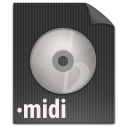SneekyD - Untitled
- Author
- SxlarEatsToes
- Type
- Kikkerland 15
- Created
- 04/03/2021 10:52
- BPM
- 110
- Length
- 256
It needs adjustment....can somebody do it for me idk how people do this its HARDDD and whoever does it for me gets to name it. I added a revers at the end.
Hole punch paper strips Export
Wow! It seems like this melody can be played offline on a 15 note paper strip music box!
All you need to do is:
- Get a 15 note DIY Music Box Kit from our online store page if you don't have one
- Export the melody to PDF with paper strips, print it out and cut with scissors. Make sure to use the right paper size and set you printer scale to 100%, otherwise the size won't match. It's better when paper strips are thick, so if you are going to use thin office paper, we recommend you to glue two or three layers together. Another option is to laminate paper strips with a transparent duct tape
- Punch holes with a tool from the music box kit
- Enjoy your favorite melody playing on a real music box!










I have some advice on making melodies:
1. Balance
・As you're placing notes, there are different segments or sections (they're separated by color). Those are called Measures or Bars. These measures help break your melody into sections. If you look at any sheet music, they're separated by lines (Bar Lines).
・Try to balance your melody by evenly separating small amounts of measures. I recommend doing 4 measures (Probably the most easiest).
2. Key Signature
This one may be a bit difficult to comprehends for beginners
・Every music have a certain key they have to follow. It doesn't matter which one you choose (it kind of depends on what mood or type of melody you're making)
・The easiest key signature is C major (to simplify, only the white notes (also referred as "Whole Notes")).
・Of course there's many other key signatures, but I recommend learning about them before you use it (if you use the key improperly, the melody may sound "off")
・More examples: F major, D major, A major, etc.
・There's also "Minors"
・Its a bit difficult to explain simply, but it's basically a Major with a certain note that is always sharp (half step higher) or flat (half step lower).
3. Key Changes (optional)
So I talked about separating sections by measures and about Key Signatures. Key Changes are kind of a twist to all of those combined.
・Key Changes are literally changing the key signature in a melody.
・At the end of a section of measures, you'll have a choice of changing the key
・The rule is that you'll have to make the transition from the current key to the new key smooth .
・If the transition is not smooth, then the new key signature may sound weird, awkward, or off.
・Also, picking the right key change will also affect the melody (picking the wrong one will also make it weird and off).
5. Theme
・In your melody, there should be a theme or a reason.
・Your melody should also be recognizable or catchy.
Also if you want to, you can add a complimentary melody.
The complimentary melody shouldn't copy the main melody, but should compliment or help the main melody.
Usually, the complimentary melody would be lower than the main melody.
0.0
I- thank you